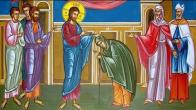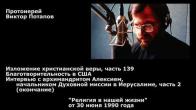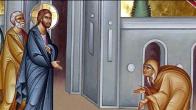You are here
November
- 20 October / 2 November -- "Hodigitria", known as "Shuiskaya"
- October 22/November 4 -- "Kazan" Icon, Andronicus Icon
- October 30/November 12 -- "Ozeryanskaya"
- November 3/16 - "Sign" of Tsarskoye Selo
- November 7/20 - "Infant Leaping for Joy"
- November 9/21 -- "Quick Hearer of Mt. Athos"
- November 11/24 -- Iveron " Montreal" Icon
- November 12/25 -- "Merciful" (Kikkos) Icon
- November 15/28 -- "Kupyatich" Icon
"Hodigitria", known as "Shuiskaya"
20 October / 2 November
The Shuiskaya Hodigitria Icon of the Mother of God appeared in the town of Shui, in the Vladimir Diocese, during the height of the plague epidemic of 1654-1655. In this time of misfortune, the town populace would hurry to pray, would gather in churches to ask the Lord that he be merciful. A certain pious parishioner of the Resurrection Church recommended to his fellow-citizens that they collect the funds needed to order a copy of the Smolensk Icon of the Mother of God, and install it in the church. That was accomplished. The Icon was written over the course of seven days, during which the residents of Shui fasted and offered fervent prayers to the Mother of God. After partaking of the Holy Gifts, they, with their priest at the head of the procession, brought the newly written icon into the church; with that, the plague ceased. In 1831, through the intercession of the Theotokos, an epidemic of cholera in Shui also came to a close. The possessed youth Jacob and many other sick people received healing from that Holy Icon.
"Kazan" Icon
22 October / 4 November
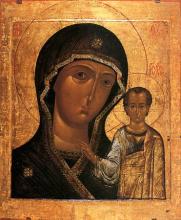 The celebration of the Most-holy Theotokos, in honor of her Icon known as the Kazan Icon, was established in thanks for the saving of Moscow and all Russia from the attack of the Poles in 1612. The late 16th and early 17th Centuries are known in Russian history as the Time of Troubles. The nation was attacked by Polish armies, who mocked the Orthodox Faith, and who looted and burned churches, towns and villages. By means of deceit, they succeeded in seizing Moscow. In response to the appeal of His Holiness Patriarch Hermogenes (commemorated on May 12) the Russian people rose up in defense of the homeland. The miraculous Icon of the Most-holy Theotokos was sent from Kazan to join the militia led by Prince Dimitry Mikhailovitch Pozharsky.
The celebration of the Most-holy Theotokos, in honor of her Icon known as the Kazan Icon, was established in thanks for the saving of Moscow and all Russia from the attack of the Poles in 1612. The late 16th and early 17th Centuries are known in Russian history as the Time of Troubles. The nation was attacked by Polish armies, who mocked the Orthodox Faith, and who looted and burned churches, towns and villages. By means of deceit, they succeeded in seizing Moscow. In response to the appeal of His Holiness Patriarch Hermogenes (commemorated on May 12) the Russian people rose up in defense of the homeland. The miraculous Icon of the Most-holy Theotokos was sent from Kazan to join the militia led by Prince Dimitry Mikhailovitch Pozharsky.
In his "Homily on the day of the appearance of the Icon of the Mother of God in Kazan" (celebrated July 8), Holy Hierarch Dimitry of Rostov (commemorated September 21) said: The Mother of God saves from great misfortunes and evils not only the righteous, but also the sinful, but what manner of sinners? Those, who like the prodigal son, return to their Heavenly Father; who lament [over their sins]; who, like the publican, beat their breasts; who are like the sinful woman that wept at the feet of Christ and washed His feet with her tears; those who, like the thief on the cross, confess Him. The Mother of God looks after such sinners and rushes to help them, and saves them from great misfortunes and evils.
Recognizing that the misfortune had been permitted because of their sins, the entire people and militia observed 3-day fast, and turned to the Lord and His most-pure mother for divine help. Their prayers were heeded. Holy Hierarch Arseny (later to become bishop of Suzdal), who was a prisoner of the Poles, sent word that he had had a vision revealing by the intercession of the Most-holy Virgin, God's judgment been had turned to mercy. Inspired by this news, the armies on October 22, 1612 liberated Moscow from the Polish occupiers. The celebration in honor of the Kazan Icon of the Most-holy Theotokos was established in 1649. To this day, that Icon is highly venerated by the Russian Orthodox people.
Akathist to the Holy Theotokos
Andronicus Icon
22 October / 4 November
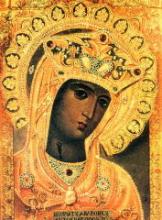 The Andronicus Icon of the Mother of God, is a miraculous icon that allegedly used to be a family icon, a holy treasure belonging to Byzantine Emperor Andronicus III Palaeologus, from whom it took its name.
The Andronicus Icon of the Mother of God, is a miraculous icon that allegedly used to be a family icon, a holy treasure belonging to Byzantine Emperor Andronicus III Palaeologus, from whom it took its name.
According to tradition, the Andronicus Icon was written by the Holy Evangelist St. Luke. According to the earliest extant documentation regarding the Icon, in 1347,
Andronicus donated it to the Monemvasia Monastery in Morea, where it remained until the early 19th Century; because of its association with that Monastery, it was also known as the Monemvasia Icon.
When many towns, including Monemvasia, were ravaged after Greece was attacked by the Turks in 1821, Bishop Agapios, abbot of the Monastery, left all of the Monastery's treasures to the enemy, except for the Miraculous Andronicus Icon, which he managed to save and take with him into hiding in Patras.Before his death, Agapios willed that Holy Icon to a relative, the Russian general consul N. I. Vlassopoulos In 1839, the general consul's son and heir, A. N. Vlassopoulos, sent it from Athens to Odessa, with an accompanying letter to His Highness Emperor Nikolai Pavlovitch, to whom the Icon was to be presented in St. Petersburg.
From 1839 to May 12 (Old Calendar) 1868, the Andronicus Icon remained at the Winter Palace, and from May 12 1868 until April 16, 1877, at Holy Trinity Cathedral in the area of St. Petersburg.
In 1877, the Icon was transferred to the Monastery of the Kazan Icon of the Mother of God near the town of Vyshiy Volotchok, in the Tver Administrative District.
The Icon was stolen in 1984, and its present whereabouts are unknown.
The Icon depicts the Theotokos to the chest, without the Divine Infant. There is a bleeding wound on the right side of the Mother of God's neck. A sheath affixed to the lower part of the Icon housed a bone handled, Damascene steel knife,with which an enemy Turk had struck the Icon; following that attack, the bleeding wound appeared on the Icon. Also affixed to the Icon was the Byzantine coat of arms - the Double-headed Eagle, attesting to the Imperial heritage of the Image. The Icon's dimensions were approximately 25 x 35 cm.
The Icon is celebrated on May 1 and October 22 (according to the Julian Calendar).
"Ozeryanskaya"
30 October / 12 November
 The miracle-working Ozeryanskaya Icon of the Mother of God was in the Kuriazhsky Monastery of the Transfiguration the Kharkov Diocese. It was glorified at the end of the 16th century in a place called Ozeryanko.
The miracle-working Ozeryanskaya Icon of the Mother of God was in the Kuriazhsky Monastery of the Transfiguration the Kharkov Diocese. It was glorified at the end of the 16th century in a place called Ozeryanko.
The following is contained in the archives of the Kharkov Spiritual Consistory: "In this [i.e. Kuriazhsky] Monastery there is a miracle-working icon, glorified in ancient times, of the Mother of God with the Pre-Eternal Child in her arms, The Icon is known as the "Ozeryanskaya" Icon. It was revealed in the wilderness, in a place known as Ozeryanko, during the time of the Tatar invasions.
While cutting the grass beyond the forest, one of the inhabitants heard a human cry erupt after he had made a pass with his scythe. He saw half of the Holy Image on the end of the scythe, and the other half, with a candle burning before it at the roots of a tree which was growing there. The man interrupted his work, took both halves of the image to his hut, placed them together in a fitting place, and diligently prayed before the Icon.
Early in the morning of the next day, he could not find the image in his hut. It had returned, whole, to the place where it had been found, and a spring of pure water had sprung forth that site.
The pious priest Theodore reported these things to his bishop, and with his permission, built a wooden church dedicated to the Nativity of the Mother of God near the place of its appearance to house it. Having seen the signs of God's grace from the holy icon, Fr. Theodore formed the intention of establishing a monastery at the place of the appearance of the Most Pure Mother of God.
On the Icon, the Mother if God is depicted with her face turned toward the Child. She is attired in a red khiton [inner garment] and a blue maphori [outer robe]. Her right hand is raised in an attitude of prayer, and with her left she supports the Christ Child, Who sits on Her knee at her left hand. The Child is clothed in a red khiton. On his head he wears the same type of crown as does the Theotokos. He holds a small Gospel in His left hand, and He blesses with His right. Both are wreathed in yellow halos.
The power of God's grace very frequently manifested itself in healings of the sick. To them the Gracious Healer of ailments granted plentiful mercies from her much-healing image. The inhabitants of Kharkov commemorated great miracles of the Mother of God shown to their city in the difficult years 1883, 1848, and 1871, when deadly cholera troubled the city and took many to their grave.
Parish Life, October 2002
"Sign" of Tsarskoye Selo
3/16 November
 From the 18th to the mid-20th century, the Tsarskoye Selo "Sign" Icon of the Mother of God was ensconced in the right part of the small palace Church of the Sign in Tsarskoye Selo.
From the 18th to the mid-20th century, the Tsarskoye Selo "Sign" Icon of the Mother of God was ensconced in the right part of the small palace Church of the Sign in Tsarskoye Selo.
The Icon is among the finest examples of iconographic art, and in its style would seem to have been of ancient Byzantine origin. It is within a gold frame set with precious stones. On the outer edges are carved the inscriptions 1831 and 1848, the years Tsarskoye Selo was spared from cholera. On a golden heartwood plaque are inscribed the words: "For your saving from the epidemic, O kind Mistress, Protector of the town of Tsarskoye Selo, accept these pearls as tears of thanks, bedewing thy most-pure riza, from thy devoted servants, and continue to have mercy on us."
The history of this icon's early days is not known to us. According to the tradition passed down by the people of Tsarskoye Selo, the Icon used to be in Moscow. It had been brought to Moscow by one of the Eastern Orthodox patriarchs, who used to frequently visit the capital of the Russian kingdom.
In all probability, this was St. Athanasius, Patriarch of Constantinople, who spent more time in Moscow than other [patriarchs], a person to whom the royal court paid great attention. He reposed in Lubno while on his way back to Constantinople, and there his incorrupt relics remain, in accordance with the practice of Eastern churches, in a seated position.
Later, during the transfer of the capital from Moscow to St. Petersburg, the Icon, considered a holy treasure belonging to the Romanovs, was taken with the other holy items in the Church of the Sign, to the new capital. Tsarevna Elizaveta Petrovna held this Icon in particular reverence, and on the night before the coup d'йtat placed it on the throne and prayed fervently before it.
In 1831, cholera spread throughout almost all of Russia, and devastated St. Petersburg. The residents of Tsarskoye Selo gathered together before the "Sign" Icon which had been placed in the center of the church, and served a solemn Moleben before it. Then they carried the Icon around the entire town while chanting hymns and prayers; the entire town, including the palaces, was within the bounds of this Procession of the Cross. The wave of cholera completely bypassed Tsarskoye Selo. In commemoration of the Mother of God's kindness toward them, the people asked the Sovereign's permission to transfer the Icon from the Icon Screen to the Nave, where it now stands, and for a directive that a Procession of the Cross like the one originally done, be made annually.
In 1848, cholera again plagued all of Russia, and the same year, the Queen of Heaven decorated her icon with a marvelous riza in an unusual way.
A pious maiden named Maria Davidova who lived in Tsarskoye Selo received help from the Miraculous "Sign" Icon on several occasions. While in a light sleep on the eve of February 28, Davidova saw the "Sign" Icon floating in the air, and herself finishing the embroidery of a beautiful riza. Davidova decided to tell her friends and relatives about her dream, and they recommended that she do what she had done in the dream. Word of the vision came to the Palace, and Empress Alexandra Fyodorovna accepted it as an inspiration from on high. Upon arriving at Tsarskoye Selo, she visited the Church of the Sign, bowed down before the Icon, and examined it carefully. Finding that the background colors were faded, and amazed at the freshness and excellent state of preservation of the faces of the Mother of God and the Pre-eternal Infant, she asked if the maiden Davidova could do a sketch of a riza, and embroider it.
Davidova was barely acquainted with drawing. Moreover, as a poor maiden, she did not know where she could find the resources for this holy work, and she fervently prayed to the Mother of God to guide her. In a dream on the eve of June 27, Davidova suddenly saw the Mother of God before her in the same form, and with the same face as depicted on the Icon. She was wearing a riza of excellent embroidery, an omophorion on her shoulders, and a head covering. Regaining consciousness, Davidova immediately wanted to get up to draw the image of the riza, but she again forgot it, and fell back asleep. The vision was repeated, even more alive and clear, so that she plainly saw the Mother of God. On awakening, she tearfully thanked the Sovereign Lady and drew the design for the riza she had seen in the vision, as we see it today. The sketch was presented to the Sovereign Empress, and was approved.
Davidova prepared for her task with repentance, confession, and Communion, and then set to work. Offerings of gold and precious stones began to come in great quantities, and one could not fail to clearly see that God's hands were touching the hearts of the donors. The flow of donations was considerably enhanced by the fact that while cholera had been wide-spread in St. Petersburg, it spared Tsarskoye Selo completely, despite its residents' constant association with the people of St. Petersburg.
Whenever it happened that Davidova did not have appropriate precious stones for a certain part of the riza, the needed treasures would suddenly come from unexpected donors. In 1849, the riza, magnificently sewn and completely covered in precious stones, was finished, and in 1853, a chromo-lithograph depiction of the Icon was published.
In 1863, the Palace of Tsarskoye Selo and its church caught fire early in the morning. The flames burned part of the Palace, and almost simultaneously ignited the cathedral cupolas and Crosses, and penetrated into the interior. Then the Sovereign and the Empress directed the removal of the Miraculous Icon from the Church of the Sign. The crowned couple had just come out to greet the Icon and reverence it, and had just begun to carry it around the burning palace, when the fire suddenly went out.
Help from the "Sign" Icon was manifested in extremely diverse ways: there were healings from illness, bringing of fertility to the barren, resolution of problems, and the saving of those perishing both on the ground and on the waves of the sea. This is why those who are well acquainted with the Icon's history have such faith in it.
On July 5/18 each year, great festivities were held at Tsarskoye Selo: after the Liturgy, the "Sign" Icon would be brought out onto an enormous plaza in front of the palace for a Moleben on bended knee, followed by a Procession around all of Tsarskoye Selo.
In the mid-1930s, the Icon was taken from the Znamensky Church to the so-called "GOSFUND" (i.e., "Government Foundation"), where it disappeared without a trace. A copy that had previously been in the vestry of the Cathedral of St. Catherine in Tsarskoye Selo, one of the copies of the Icon made in the early 19th century, was given to the Church as a replacement for the lost Icon. In 1943, as part of the German evacuation from Tsarskoye Selo, that Icon was transferred to Gatchina, and later to the Baltic States. Found in Riga, it was returned to the city on the Neva. Since 1946, that Icon has been in the church of the St. Petersburg Theological Academy and Seminary.
(Originally published in the magazine St. Petersburg Diocesan Gazette, Issue Nbr. 30-31, 2003. Published here abridged.)
"Infant Leaping for Joy"
7/20 November
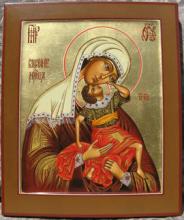 On November 20 according to the new calendar, the Orthodox Church celebrates the finding of the Icon of the Mother of God known as the “Infant Leaping for Joy Icon” or “Joyful Icon.” The Icon first appeared on November 7, 1795 at the Nikolo-Ugreshsky Monastery, which is not far from today’s Dzerzhinsk, a city near Moscow. The Monastery gained renown as having been founded by Dimitry Donskoy in honor of the 1380 victory achieved at Kulikovo Polye [Snipes’ Field], on the place where a large icon of St. Nicholas the Miracle-worker appeared.
The Most-holy Theotokos is depicted with the Child, Who is seated to the right. She supports the Young Christ with both hands. The Mother and Son are snuggled against one another in token of their boundless filial and maternal love. On the reverse of the Icon there is a prayer: “O Most-holy Theotokos, by thy prayers, save all who run to thee, and deliver [them] from all need and sorrow.”
On November 20 according to the new calendar, the Orthodox Church celebrates the finding of the Icon of the Mother of God known as the “Infant Leaping for Joy Icon” or “Joyful Icon.” The Icon first appeared on November 7, 1795 at the Nikolo-Ugreshsky Monastery, which is not far from today’s Dzerzhinsk, a city near Moscow. The Monastery gained renown as having been founded by Dimitry Donskoy in honor of the 1380 victory achieved at Kulikovo Polye [Snipes’ Field], on the place where a large icon of St. Nicholas the Miracle-worker appeared.
The Most-holy Theotokos is depicted with the Child, Who is seated to the right. She supports the Young Christ with both hands. The Mother and Son are snuggled against one another in token of their boundless filial and maternal love. On the reverse of the Icon there is a prayer: “O Most-holy Theotokos, by thy prayers, save all who run to thee, and deliver [them] from all need and sorrow.”
This ancient image was copied from a Greek icon that in Byzantium was considered to be a miracle-working holy treasure. There are icons entitled the “Infant Leaping for Joy” in Moscow’s Novodevichy Monastery and in the Vatopedi Monastery on Mt. Athos.
Since long ago, pilgrims have been drawn to this Icon. They include many couples who do not have children, pregnant women, and mothers of ailing infants. The Most-holy Theotokos heeded their prayers, and the Icon gained renown as being miraculous. Women desirous of having children pray before it, while others pray for the health of their infants. It is customary to serve a Moleben and Akathist before the “Infant Leaping for Joy” Icon during one’s pregnancy and when one is about to go into labor.
In Orthodoxy, it is customary to accompany the bearing of a child below one’s heart [i.e in utero] with prayer, for pregnancy and birthing are important events manifesting the Divine greatness of the life being born. Historically, it was felt that a pregnant woman should observe an especially righteous way of life, for in her womb a new life was growing. The pregnant woman should see to her soul, should strive not to rise to anger, but rather should be kind and gentle. She should refrain from being envious or saying spiteful things, and overall should strive to root out from herself all faults and vices. That is what our ancestors thought, and that is what learned people believe today: the pregnant woman’s thoughts, feelings, and actions inevitably are passed on to her little one.
After the bloody events and the destruction of the monastery in 1918, it seemed that the Icon had been lost forever. For many years, its location was unknown. However, in 2003, a woman telephoned the Nikolo-Ugreshsky Monastery and announced that in her home, there was an icon that very much resembled the miraculous “Infant Leaping for Joy” Icon. The woman told the nuns who came to see her that the Icon had been sold to her family by a certain collector who insisted that it was from the Nikolo-Ugreshsky Monastery. Upon examining the Icon, the nuns became certain that it was really the long-lost Icon. Thus did the Miraculous Icon return to the Monastery. Today the “Infant Leaping for Joy” Icon is in the Altar of the Church of the Holy Transfiguration.
"Quick Hearer of Mt. Athos"
9 November / 22 November
The Icon of the Mother of God known as the "Quick Hearer" Icon is an ancient, miraculous Image in the Monastery of Dochiarou on Holy Mt. Athos. According to monastic tradition, it was written in the 10th Century, while St. Neophytos [commemorated 9/22 November] was rector of the Monastery. One night in 1664, Nil, the refectory steward, was passing by with a lighted torch. From the Icon of the Theotokos hanging above the door, he heard a voice tell him to no longer pass that way and sully the Icon with soot. The monk, thinking that it was some kind of joke played on him by one of the brethren, disregarded the miracle and continued to carry a lighted torch into the refectory. Suddenly, he was struck blind. Rueful and repentant, Nil prayed before the Icon of the Mother of God, asking her forgiveness. Once again he heard the miraculous voice, which announced that he was forgiven, that his sight was restored, and that he was to relate everything to the brethren. "From henceforth, My Icon will be known as the "Quick Hearer" Icon, for I will quickly show mercy and grant the wishes of those who come to me." The most-holy Theotokos fulfilled, and still fulfills, her promise. She grants quick assistance and comfort to all who come to her in faith.
In Russia, copies of the miraculous Athonite "Quick Hearer" Icons have always been greatly loved and respected. Many of them have become renowned for miracles, especially miraculous healing of the diseased or possessed.
In 1938, The Athonite Monastery of Dochiarou gave the Russian Ecclesiastical Mission in Jerusalem a copy of the Miraculous "Quick Hearer" Icon of the Mother of God.
"Montreal" Iveron Myrrh-streaming Icon
11/24 November
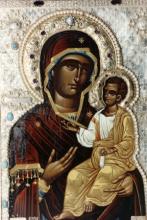 The Iveron Icon, which at present is preserved in a monastery on Athos, by tradition was painted by the Apostle and Evangelist Luke. In November 1982, a copy of the Iveron Icon of the Mother God began to stream myrrh in Canada. In 1983, the Icon was in Washington for the first time, and I then asked its guardian - the Spaniard Josй Muсoz - how he had received the Holy Object, and when it had begun to stream myrrh. Here are his own words, which were recorded during our conversation with him:
The Iveron Icon, which at present is preserved in a monastery on Athos, by tradition was painted by the Apostle and Evangelist Luke. In November 1982, a copy of the Iveron Icon of the Mother God began to stream myrrh in Canada. In 1983, the Icon was in Washington for the first time, and I then asked its guardian - the Spaniard Josй Muсoz - how he had received the Holy Object, and when it had begun to stream myrrh. Here are his own words, which were recorded during our conversation with him:
"Once during our pilgrimage on Athos, after several hours of walking, we got lost. It began to get dark. We needed quickly to find shelter for the night. Going along a path, we stumbled upon a small, poor scete. There the fourteen Greek monks of the scete were engaged in iconography. They received us very cordially. Having rested a little, we began to examine the icons of their work. One of my fellow-travellers, who spoke Greek, got into a conversation with the monks and told them who and from where we were. I, though, taking advantage of the mo-ment, began more attentively to examine everything round about. Suddenly my gaze stopped at an icon of marvellous artistry with dimensions of approximately fifteen by twenty inches. I asked a monk if he could not sell it to me. He refused me, having explained that that image was the first which had been painted in that scete and therefore would not be sold. I could not tear my eyes from that wondrous icon. We stayed the whole night in the scete and in the morning stood through the Liturgy. During the singing of "It is truly meet", I begged the Queen of Heaven on my knees to let the Holy Image go with me... Bidding farewell in the morning, all the monks accompanied us, but the hegoumen was not among them. And then at the last minute before our departure from the monastery we saw him: he quick descended the staircase with the wrapped-up icon in his hands. He came up to me and said: "Take it. I am gifting it to you. It must be with you." I offered to pay for the icon, knowing that the monks were needy; but the hegoumen said severely: "One must not take money for such a holy object!" I crossed myself, kissed the image and made a vow to myself that that image would never become the source of my enrichment....
"After this, we set out at once for Iveron Monastery in order to receive the superior's blessing and to touch the icon received by me to the Original, which is preserved in this famed monastery. But far from everyone is allowed to approach and permitted to touch the ancient Wonderworking Icon. Glory be to God, we were permitted! In the chapel, we knelt and, gazing at the holy object, froze in prayer before the image of the Iveron Mother of God. The image was so majestic, so shiningly beautiful and radiated such spiritual power that it was difficult to gaze at it for long! A hieromonk helped me touch my copy to the Original.
"Soon after this we went home to Canada. We returned on 3 November 1982. I put the icon next to the relics of the saints of the Kiev Caves Lavra and the New-martyr Elizabeth Feodorovna, which had been received by me from the reposed Archbishop Leonty of Chile. A lampada flickered before it all the time, and each day before sleep I read Akathists to it. On the 24th of November, I was awakened at three o'clock in the morning by the powerful aroma of roses - the whole room was filled up by it. At first I thought that it emanated from the relics or from a spilt vial of perfume; but, on approaching the icon, I was struck! The whole icon was covered with oil - a fragrant oil! I froze on the spot at such a miracle!"
Soon after the beginning of the Iveron Icon's myrrh-streaming, news of it spread instantaneously around all the parishes of the Russian Church Abroad and other Orthodox Churches. Since 1982, the Icon has visited Orthodox parishes in many countries of the world. At the end of 1995, it was in Bulgaria, where more than sixty thousand of the faithful prayed before it, and each was individually anointed with its holy oil. Everywhere it has brought comfort and, by the prayers of the faithful, miracles.
Iveron Icon of the Mother of God
"Merciful" (Kikkos) Icon
12/25 November
According to tradition, this Icon was written by the Holy Evangelist Luke. It received its name, the “Kikkiotisa,” from Mt. Kikkos, on the island of Cyprus, where it lies in an Imperial monastery, in a church erected in its honor. By the will of God, the Miraculous Icon of the Theotokos traveled for a long time before arriving in Cyprus. At first it was in one of the first Christian communities in Egypt, then was taken to Constantinople, where it remained until the reign of Alexius Comninus (late eleventh to early twelfth century). It was during this period that, in a miraculous vision, the Elder and Anchorite Isaiah learned that through his efforts, the Miraculous Image written by the Holy Evangelist Luke would come to the island of Cyprus. The Elder expended great efforts to accomplish what had been shown him in the divine vision. Miracles began to flow from the Icon of the Mother of God once it arrived on the island. From ancient time and up to the present day, multitudes of people fettered by every ill imaginable have come from all over the world to the Icon, where they receive healing according to their faith. It is not only Christians that believe in the miracle-working power of the Holy Icon. People of other faiths run to it in their time of sorrows and illnesses. The mercy of the Most-pure Theotokos, intercessor for all those who suffer, is limitless, and it is truly appropriate that her Icon is known as the “Merciful One.” The Miraculous Kikkos Icon of the Mother of God has a remarkable feature: Since some time long in the past, a veil draped from the upper left corner to the right lower corner has covered one-half of the Icon, so that no one may see, or dare to try to see, the faces of the Mother of God or the Divine Infant. The depiction of the Mother of God is of the Hodigitria type, similar to that on the Smolensk Icon of the Mother of God. The Theotokos wears a crown.
Currently, there is a much-revered copy of this Icon in the women’s monastery of St. Nicholas in the city of Mukachev.
"Kupyatich" Icon
15/28 November
"Kupyatitch" Icon of the Mother of God appeared in the year 1180 near the village of Kupyatich, in the Pinsk District of the Province of Minsk. A peasant girl named Anna, who was tending livestock, found the icon on a tree in the forest. The Image, which was in the form of a cross, shone forth with an unusual light. At the site of its miraculous appearance, the peasants constructed a church in honor of the Most Holy Theotokos, and in it installed the newly discovered Icon. Several years later the Tartars burned down this church. The Icon was again found, by a traveler named Joachim who happened to be passing by, at the site of the destroyed church. The peasants transferred the Icon-Cross to the village church, where by Divine inspiration, Joachim became the sexton. In the beginning of the 17th century the Kupiatitsky Monastery was founded near the church. At the close of the Century, the monastery was seized first by [Roman] Catholic, then by Uniate monks. The Orthodox monks left the monastery, and took with them the Holy Kupyatich Icon of the Theotokos. They translated the Holy Icon to the Cathedral of the Holy Wisdom in Kiev. "Kupyatich" icon is actually a small copper Cross. On one side of the Cross the Mother of God and the Pre-eternal Infant are depicted, and on the other, the Crucifixion. Those that are sick with palsy are healed with prayer before the miraculous Kupyatitsk Icon of the Mother of God.
PARISH LIFE
RECENT VIDEOS
Address of our Cathedral
Subscribe to our mailing list
While all the materials on this site are copyrighted, you may use them freely as long as you treat them
with respect and provide attribution on the Russian Orthodox Cathedral of St.John the Baptist of Washington DC.



